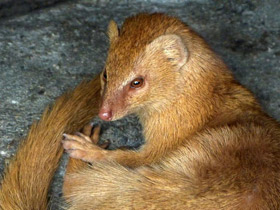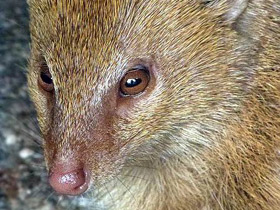The common slender mongoose, the black-tipped mongoose or the black-tailed mongoose (Herpestes sanguineus)
The common slender mongoose (Herpestes sanguineus), also known as the black-tipped mongoose or the black-tailed mongoose, is a very common mongoose species native to sub-Saharan Africa.
Taxonomy
The scientific name Herpestes sanguineus was proposed by Eduard Rüppell in 1835 who described a reddish mongoose observed in the Kordofan region.
Habitat
Galerella sanguinea is a species of carnivorous mammal in the family Herpestidae.
Galerella sanguinea is widely distributed in sub-Saharan Africa. It is absent only in the southern half of South Africa and in the dense forests of Equatorial Africa. Galerella sanguinea avoids true deserts and prefers savannahs and other semi-arid regions. They can occupy a wide variety of habitats, but are attracted to more arid and open habitats (although they are excellent tree climbers).
Appearance
Galerella sanguinea reaches a length of 27.5-40 cm, with a tail of 23-33 cm. Males weigh between 640 and 715 g and females between 460 and 575 g. The colouring of the coat varies greatly depending on the subspecies, from dark red-brown to orange-red, grey and yellowish. Galerella sanguinea differs from other mongooses in having a black or red tail tip.
Nutrition
Galerella sanguinea feeds on small invertebrates and vertebrates: lizards, amphibians, snakes, rodents and birds. It also eats a small amount of fruit, as well as eggs and carrion. Like many other mongooses, Galerella sanguinea can kill venomous snakes, but these make up only a small part of its diet. This critter is more agile than its relatives: it is good at climbing trees and bushes while hunting birds.
Social behaviour and reproduction
Galerella sanguinea live singly or in pairs. They are mostly active during the day, but may also forage for food during warm, moonlit nights. The species probably has no clear boundaries, however it always stays in one area, which it often shares with other mongooses or Viverridae. Often, different species use the same shelter, as related species, unlike Galerella sanguinea, are more active at night. Shelters are established in rock crevices, tree hollows or between roots, as well as in abandoned burrows of other animals.
The male's territory often overlaps with that of several females, and the male learns to be prepared for mating by his secretion. Pregnancy probably lasts 60-70 days. The female gives birth to one to three cubs (often twins). The male does not participate in the rearing of the pups. After one year, the pups reach sexual maturity. Unfortunately, Galerella sanguinea is harvested locally for its meat and is also used in traditional medicine.
Conservation
The common slender mongoose has been targeted by extermination efforts in the past, due to its potential to be a rabies vector and the fact that it sometimes kills domestic poultry. These efforts have not been conspicuously successful, although some subspecies may be threatened. It is in no immediate danger of extinction, and is IUCN Red Listed as least concern.

















































